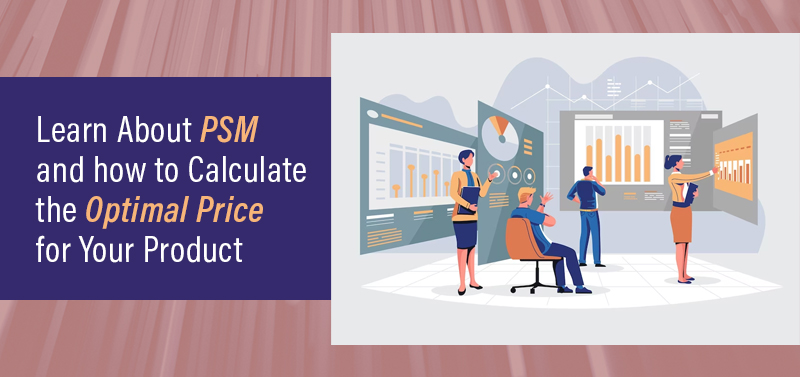Learn About PSM and how to Calculate the Optimal Price for Your Product
As your business gears up to release a new product, one crucial factor to consider is pricing. To help you determine the optimal price point, you may want to use a price sensitivity meter. This tool can help you gauge how much customers are willing to pay for your product, based on factors such as its perceived value, competition, and market demand.
What is a Price Sensitivity Meter?
Developed by researcher Van Westendorp in 1976, this common method is a valuable tool in market research and is used by businesses to gauge how consumers will react to changes in pricing for their products or services. Through surveys and experiments, businesses can gather data on consumer preferences and price sensitivity. By presenting different price options and asking respondents to indicate their likelihood of purchasing at each price point, businesses can analyse the responses to determine the price sensitivity of their target market. This information can then be used to make informed pricing decisions and optimise sales.
Price Sensitivity Meter Questions
To accurately determine the optimal price for a product or service, simply asking consumers what they think it should cost is not enough. Instead, it's important to understand the range of prices that consumers are willing to pay. A Price Sensitivity Meter, asks the target audience four key questions to identify the upper and lower limits of their price range.
- Price threshold for not considering buying: At what price would the product or service become prohibitively expensive, leading to a decision not to purchase it?
- The price point for considering it expensive but still buying: At what price would you consider the product or service expensive, yet still be willing to make the purchase due to its perceived value or other factors?
- Price level to raise doubts about the quality and refrain from buying: At what price would the product or service be so cheap that you start questioning its quality, reliability, or authenticity, leading to a decision not to buy it?
- The price range for a bargain or great buy: At what price would the product or service offer exceptional value for the money, making it a fantastic purchase compared to similar items in the market?
By understanding this range, businesses can set prices that are both attractive to consumers and profitable for the company.
Price Sensitivity Meter Analysis
The Price Sensitivity Meter, also known as the Van Westendorp pricing analysis, provides a clear and easy-to-understand graph of consumer responses. The X-axis represents the price range, while the Y-axis shows the percentage of consumers willing to pay that price. To plot the graph, two curves representing the percentage of consumers who perceive the price as either "cheap" or "expensive" must be reversed. This creates four curves, and the intersection of these curves reveals the optimal price range for the product. However, determining the specific price point within this range that will result in sufficient consumer purchases requires further analysis.
Identifying the Price
When it comes to pricing a product, finding the sweet spot between "too expensive" and "too cheap" is key. This is known as the "Optimal Price Point," where an equal number of potential buyers consider the price to be either too high or too low. At this point, there is the least amount of resistance to purchasing the product. On the other hand, the "Indifference Point" is where an equal number of people view the price as either cheap or expensive, indicating a balanced perception of the price. By identifying these two points, businesses can determine the ideal price for their product.
Identifying the Price Range
The Price Sensitivity Meter not only helps determine the optimal price for a product or service but also establishes a price range. The highest price limit is at the intersection of the "not expensive" and "too expensive" curves, also known as the "Point of Marginal Expensiveness". Going beyond this limit may result in lower sales and damage to the product or brand image due to excessive pricing. On the other hand, the lowest price limit is at the intersection of the "not favourable" and "too favourable" curves, known as the "Point of Marginal Cheapness". Falling below this limit may lead to the perception of inferior quality and harm the product or brand image. The price range should encompass a price point that consumers are willing to pay, between the upper and lower price limits.
How Can Vodus Help You to Create Optimal Pricing Strategies
Setting the right price for your products or services can be a challenging task, especially when you need to consider changing market trends and customer expectations. To stand out from your competitors, you need to offer competitive prices without undervaluing your offerings. The Van Westendorp Price Sensitivity Meter is a tool that can help you determine the optimal pricing strategy for your business. With this tool, you can avoid guesswork and hesitation in setting prices for all your products and services. The best part is that this is included in the Vodus Research market research solutions, making it easily accessible for businesses of all sizes.
Vodus Research employs a unique One-question Media Tracking Online Survey (OMTOS) method that surveys 17 million Malaysian consumers instantly. With our extensive experience in research and expertise in the Malaysian market, we are able to provide clients with detailed optimal pricing strategies and market insights necessary for success.
More Article


Where do Malaysians shop for their skincare?

Malaysia Property Market Outlook (Q4 – 2019)


